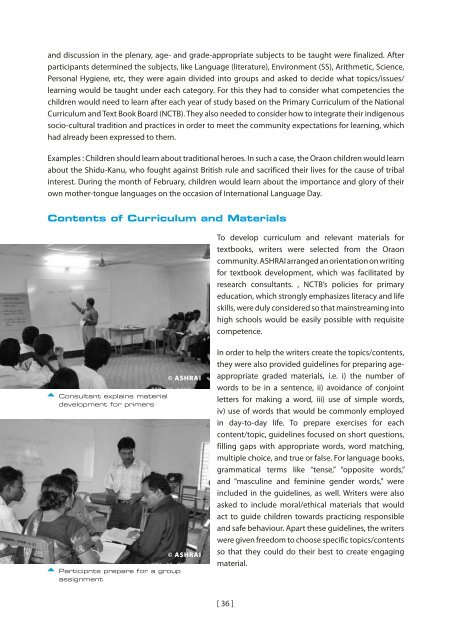Mother Tongue-based Literacy Programmes: Case Studies of Good ...
Mother Tongue-based Literacy Programmes: Case Studies of Good ...
Mother Tongue-based Literacy Programmes: Case Studies of Good ...
Create successful ePaper yourself
Turn your PDF publications into a flip-book with our unique Google optimized e-Paper software.
and discussion in the plenary, age- and grade-appropriate subjects to be taught were finalized. Afterparticipants determined the subjects, like Language (literature), Environment (SS), Arithmetic, Science,Personal Hygiene, etc, they were again divided into groups and asked to decide what topics/issues/learning would be taught under each category. For this they had to consider what competencies thechildren would need to learn after each year <strong>of</strong> study <strong>based</strong> on the Primary Curriculum <strong>of</strong> the NationalCurriculum and Text Book Board (NCTB). They also needed to consider how to integrate their indigenoussocio-cultural tradition and practices in order to meet the community expectations for learning, whichhad already been expressed to them.Examples : Children should learn about traditional heroes. In such a case, the Oraon children would learnabout the Shidu-Kanu, who fought against British rule and sacrificed their lives for the cause <strong>of</strong> tribalinterest. During the month <strong>of</strong> February, children would learn about the importance and glory <strong>of</strong> theirown mother-tongue languages on the occasion <strong>of</strong> International Language Day.Contents <strong>of</strong> Curriculum and MaterialsTo develop curriculum and relevant materials fortextbooks, writers were selected from the Oraoncommunity. ASHRAI arranged an orientation on writingfor textbook development, which was facilitated byresearch consultants. , NCTB’s policies for primaryeducation, which strongly emphasizes literacy and lifeskills, were duly considered so that mainstreaming intohigh schools would be easily possible with requisitecompetence. Consultant explains materialdevelopment for primers© ASHRAI© ASHRAI Participnts prepare for a groupassignmentIn order to help the writers create the topics/contents,they were also provided guidelines for preparing ageappropriategraded materials, i.e. i) the number <strong>of</strong>words to be in a sentence, ii) avoidance <strong>of</strong> conjointletters for making a word, iii) use <strong>of</strong> simple words,iv) use <strong>of</strong> words that would be commonly employedin day-to-day life. To prepare exercises for eachcontent/topic, guidelines focused on short questions,filling gaps with appropriate words, word matching,multiple choice, and true or false. For language books,grammatical terms like “tense,” “opposite words,”and “masculine and feminine gender words,” wereincluded in the guidelines, as well. Writers were alsoasked to include moral/ethical materials that wouldact to guide children towards practicing responsibleand safe behaviour. Apart these guidelines, the writerswere given freedom to choose specific topics/contentsso that they could do their best to create engagingmaterial.[ 36 ]

















